
 |
Cristobal Cobo
University of Oxford, United Kingdom
Over the last decade, open educational resources (OER) initiatives have created new possibilities for knowledge-sharing practices. This research examines how, where, and when OER are attracting attention in the higher education sector and explores to what extent the OER discussion has moved beyond the English-speaking world. This study analysed English, Spanish, and Portuguese OER queries over a long-term period (2007-2011). The data retrieval was conducted using four online platforms: two academic journal databases (Web of Knowledge and Scopus), one video-sharing Web site (YouTube), and one document-sharing Web site (Scribd). The number (more than 32,860) of search results collected indicate an increasing interest in online OER discussion across languages, particularly outside academic journal databases. Additionally, a widening ‘language gap’ between OER discussions in English and other languages was identified in several platforms. This research reports some of the cultural and language challenges caused by the expansion of the OER discussion and highlights relevant findings in this field.
Keywords: Open educational resources; education; digital technologies; language gap
Open educational resources (OER, see Table 1 for definitions) are an increasingly important part of the current discourse on education. Discussions about OER are generating significant interest regarding how these resources can increase access to and quality of education, reduce educational inequality, and decrease educational costs, particularly in developing countries (Hatakka 2009; Kanwar, et al. 2010; Masterman & Wild, 2011). In this context, the United Nations Educational, Scientific and Cultural Organization (UNESCO) and the Commonwealth of Learning have been collaborating to establish global guidelines to promote OER worldwide (UNESCO & COL, 2011).
The three aims of this article are to (1) provide a theoretical overview to contextualise the current discussion about knowledge sharing and open access initiatives within the higher education (HE) sector; (2) identify some critical perspectives on OER in terms of language diversity, particularly addressing English, Spanish, and Portuguese-speaking contexts; (3) present and discuss empirical data collected over time about OER online content in English, Spanish, and Portuguese.
The key questions explored in this paper are the following. Is the OER discussion occurring beyond the English-speaking world? What evidence is there for English, Spanish, and Portuguese online content about OER in both academic and non-academic journals? Finally, is it possible to identify changes over time in online content about OER and in all three languages?
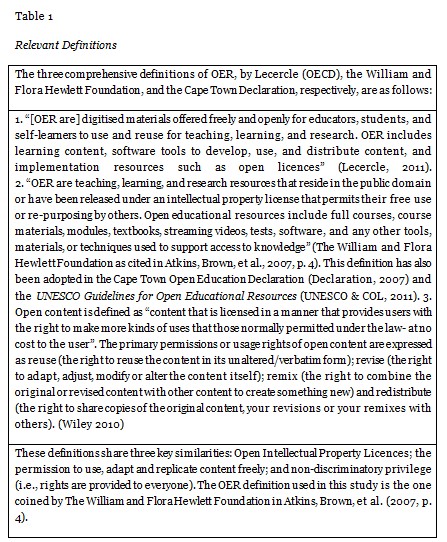
The knowledge economy is a new socio-economic order in which new technologies are the drivers of knowledge production and application. Universities are expected to become a key part of the innovation system in which innovation is understood as product development (Häyrinen-Alestalo & Peltola, 2006, p. 253; Lecercle, 2011). As Hurmelinna, Kyläheiko, and Jauhiainen argued, new “mechanisms of knowledge creation, integration and transfer, play a central role in the evolutionary economics-based dynamic capability” (2007, p. 142).
In 1998, Wiley coined the term open content and defined it as the use of open licences applied to licensed information that can be used freely. This concept, which is closely related to the principle of free software, stresses open source movements and applies to content with an open licence, also known as an Open Publication License (Wiley & Gurrell, 2009). In 2001, supported by structured and consistent legal support, Creative Commons created a flexible set of licences that improved the Open Publication License (2001). Both contributions and the support of a growing community helped promote the visibility and credibility of new forms of academic knowledge sharing and content exchange.
Another term that gained increasing relevance was open access; it was coined and formally defined by an international group of faculty members, publishers, and librarians that had come together in Budapest in 2002 by the Open Society Institute (Willinsky, 2010; Velterop, 2007). The Budapest Open Access Initiative (2002) defined open access as
free availability on the public internet, permitting any users to read, download, copy, distribute, print, search, or link to the full texts of [scholarly or scientific] articles, crawl them for indexing, pass them as data to software, or use them for any other lawful purpose, without financial, legal, or technical barriers other than those inseparable from gaining access to the internet itself. The only constraint on reproduction and distribution, and the only role for copyright in this domain, should be to give authors control over the integrity of their work and the right to be properly acknowledged and cited.
Björk and Paetau (2012) clarify that despite the importance of the Budapest Initiative the concept has existed since the earliest days of the World Wide Web : “As soon as the web emerged, many scientists rapidly saw its potential for making the sharing of scientific information, in particular peer-reviewed journal articles, more efficient.”
The term open educational resource is the result of a meeting held in 2002 by UNESCO (2002). That meeting discussed three aspects of OER: technology support (standards for dissemination and exploitation); the methodology for organizing international cooperation (frameworks for collaboration); policy issues (institutional commitment, financial support, and intellectual property).
In 2001, MIT introduced OpenCourseWare (OCW), a free and open digital publication of high quality educational materials organised as courses. Four years later, the OCW Consortium became a global organisation that included non-English-speaking countries and regions such as Latin America, Europe, Africa, China, and Japan. Hodgkinson-Williams, Willmers, and Gray (2009) argued that the interest in OER dates back to MIT’s initiative to make its course materials available free of charge, which radically changed the traditional model of teaching and learning.
According to the Higher Education Academy and JISC (2011), OER boosts opportunities for learning by applying knowledge over a wider context (new opportunities for learning); improves materials based on open review purposes (student/user provides open peer review); contributes to reputational benefits, providing important exposure for faculty and institutions (visibility and recognition); and increases the sharing of ideas (new opportunities for people to exchange ideas about the resources provided).
After adopting OER initiatives, some universities have attracted millions of online visitors. Examples at English-speaking universities are iTunesU at the University of Oxford, with 12 million downloads, and Open Yale Courses, which registered more than 3 million visits between 2008 and 2011 for a combined total of over 15 million visits to their YouTube and iTunesU channels (Yale News, 2011). In 2006, Open University created OpenLearn (OL), which has recorded over 10 million visits.
Ten years later, D’Antoni (as cited in Inamorato et al., 2012, p. 11) offers an overview about the evolution of the OER movement:
[it] has grown substantially; there are more and more initiatives in more and more countries. In a sector that is sometimes criticized for its slow pace of change, this is a significant development. Using digital technology to create resources and making them available with an open license by means of the Internet and the Web greatly enables the sharing. Yet, being aware of the considerable number and range of Open Educational Resources worldwide remains key to their use.
In the international scene the OER movement has grown consistently with new initiatives, declarations, and guidelines on OER such as the 2007 Cape Town Open Education Declaration, the 2009 Dakar Declaration on Open Educational Resources (UNESCO at al., 2009), and the 2011 Commonwealth of Learning and UNESCO Guidelines on Open Educational Resources in Higher Education (UNESCO & COL, 2011), which promotes open resources, technology, and new learning possibilities. This growing phenomenon raises the following question: To what extent are non-English-speaking HE institutions discussing and adopting OER ideas?
In recent years, UNESCO (2012) has stressed that OER can offer a new dynamic of sharing that will provide potential learning benefits for users, particularly in developing regions (Daniel, et al., 2006; d’Antoni, 2008). Conversely, Hatakka (2009, pp. 1–2) noted that the promised benefits of OER for developing regions are not necessarily realistic because “open content is not being used by educational organizations in developing countries (or rather the usage of the free resources is low).” Contextualisation of resources presents significant obstacles to the effective reuse of OER than was originally anticipated (Kanwar, et al., 2010).
Furthermore, Stacey (2007) highlighted that top-down knowledge cooperation flow and OER provision from developed countries to other regions generated a number of cultural barriers. There are still a large number of learners and educators in developing countries who do not have the skills to effectively use, develop, or repurpose OER. In this regard, contextualisation is considered a conditio sine qua non for a more culturally grounded understanding of adoption of OER (Willems & Bossu, 2012). While there are particular OER initiatives in developing countries (see OER Africa, www.oerafrica.org, SciELO, www.scielo.org, Redalyc, http://redalyc.uaemex.mx), the immense majority of OER are produced by individuals, organisations, or institutions from developed countries, and this imbalance is problematic (Hatakka, 2009).
Willems and Bossu (2012) critically evaluated the notion of OER because “the rhetoric around OER is their potential to increase access to education, improve quality, and reduce the cost of education in many developing countries”. Nevertheless, these authors claimed that cultural elements such as the language of instruction, contextualisation, and technological infrastructure in remote regions are not sufficiently taken into account. Furthermore, OER cannot be used effectively in many developing countries because of the absence of basic infrastructure, such as internet connectivity, thus potentially widening the inequality gap. Internet penetration is 60% in the EU, 78% in the USA, and 89% in Australia, while internet penetration in Latin America and Africa is only 39.5% and 13.5%, respectively (Internet World Stats, 2011).
Richter and McPherson (2012) added that OER will not lead to radical transformation in developing countries because cultural barriers are much stronger than the access to and influence of online educational content. These authors emphasised the obstacles including the historical effects of colonisation, the language barrier, and the need for basic skills.
The OER debates are focused on top English-speaking universities. By contrast, there is less evidence of OER-HE engagement and long-term sustainability in non-English-speaking regions (Lecercle, 2011). Klemke et al. (2010, p. 75) added that the “language differences, cultural barriers, local relevance of materials, access concerns, and the availability of adequate technical resources (infrastructure)” can hinder a broader adoption of OER. The authors asserted that a “cultural hegemony” based on continuous improvements in the quality of English OER implies that language barriers and cultural differences could consign less developed countries to the role of “consumers” of expanding knowledge – rather than contributors to it. As long as educational materials continue to be based on a few (Western European) languages (Ouane, 2003), the use and repurposing of OER remains limited to people who have had the privilege to learn one of those elite (foreign) languages.
The production of OER in English, therefore, creates a barrier to guaranteeing the universal use or understanding of content. Rossini (2010, p. 21) adds,
the language barrier should be added as an enormous socio-cultural barrier, since the vast majority of OER is in English and based on Western culture, limiting relevance outside Western culture. This further carries the risk of consigning developing countries to be placed in the role of consumers.
These limitations (i.e., teachers blocked by the language barriers) have been recently documented among the Chinese-speaking community (Huang et al., 2012), as well as among Russian (Knyazeva, 2010) and Italian speaking (Banzato, 2012) groups interested in OER. The problem of linguistic diversity is not only relevant for the OER discussion, as Meneghini and Packer (2007, p. 112) explained: “English has become the modern lingua franca [… where] any scientist must therefore master English—at least to some extent—to obtain international recognition and to access relevant publications.” Stankus also noted that “virtually all non-English authors tend to abandon publications in non-English language journals” (Stankus, 1987, p. 82).
In the case of OER, a particular tension exists between the inclusive rhetoric about OER (Daniel, et al., 2006; d Antoni, 2008) and the reality that most of the academic publications in this field are in English. Willems and Bossu (2012, p. 191) added that “English is considered an international language due to its usage in knowledge dissemination […] However, the majority of learners worldwide come from non-English-speaking backgrounds.”
The Organization for Economic Co-operation and Development (OECD) asserts that “no definite statistics are available, but it [OER] has expanded in terms of number of projects, number of people involved, and number of resources available. It is a global development, although most resources are currently produced in developed countries” (Lecercle, 2011). Masterman and Wild (2011, p. 5) suggested that the lack of comprehensive OER statistics and the adoption of OER practices could be compared to an “iceberg.” Above the surface is a limited amount of highly visible licensed OER that bear the name of a well-known institution. However, below the surface is a much greater volume of reused, non-OER digital materials that are used by staff and students and that are often invisible beyond a specific course. The invisible OER are mostly excluded from statistics.
This study is a comparative analysis of queries in four major digital platforms to determine the coverage of OER online content. Acknowledging the problem of linguistic diversity, this research provides a comparative analysis that evaluates the evolution of the OER discussion (OER related queries) in English, Spanish, and Portuguese from 2007-2011.
These queries are defined as the words or phrases that a user enters into search engines and directories to find specific results. Eight queries associated with the OER discussion in English, Spanish, and Portuguese were entered into four different online platforms: two academic journal databases (Web of Knowledge and Scopus), one video-sharing Web site (YouTube), and one document-sharing Web site (Scribd). The resources included in the study were the uploaded (or registered) content to these four platforms during the period 2007-2011.
This methodology included the following steps.
Step 1. Selection of queries about OER in three different languages (Table 3).
Step 2. Selection of academic and non-academic online platforms to conduct the comparative analysis.
Step 3. Elaboration of search results on each platform (Table 3). The searches were differentiated by query, platform, and year.
Step 4. Based on the data retrieved by the search engine of each platform, presentation, comparison, and analysis of the results.
According to the information provided by Internet World Stats (2011), the top languages on the Internet are English, Chinese, Spanish, Japanese, and Portuguese (Table 2). Table 2 illustrates that for every Portuguese speaker, there are two Spanish speakers and approximately seven English speakers on the Internet. The reason for choosing these two Western European Languages (Fishman, 1997), Spanish and Portuguese, instead of other highly ranked languages, such as Chinese or Japanese, is attributable to its use among a large number of developing countries with particular predominance in the Latin American region.
Spanish and Portuguese are spoken beyond their countries of origin (Spain and Portugal, respectively). For example, in the United States, 12.8% of the residents speak Spanish (US Census Bureau, 2012). Additionally, these languages are illustrative of other communities where Spanish and Portuguese are spoken with extensive idiom use. Latin America (approximately 600 million people) and eight African countries (Lewis, 2009) are additional examples of regions with Spanish and Portuguese-speaking populations.
Different authors indicate that academic journal databases such as the Web of Knowledge or Scopus provide a limited or under-represented number of publications in languages other than English (González-Alcaide et al., 2012; Meho & Yang, 2006). Larivière et al. added that Thomson ISI “fail(s) to cover a good part of the literature published outside the United States and the United Kingdom, whether the language used is English or not” (2006, p. 998). Despite the clear language imbalance described, these journal databases were included because they are considered sources of academic excellence in non-English speaking countries (Cartes-Velásquez & Aravena Torres, 2012; García-Cepero, 2008). Finally, for this study it was considered that a search of a journal database could demonstrate the language and development of OER content over time. YouTube and Scribd were also included in the sample to provide diversity: Both resources are non-academic platforms largely used by a multilingual community (YouTube, 2012; Scribd, 2012).
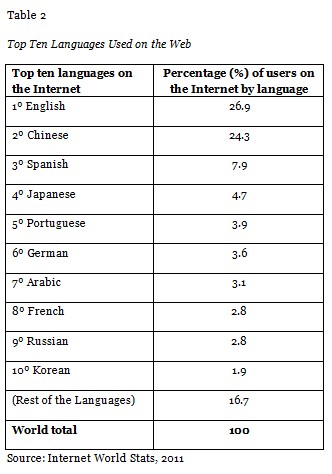
a) Identify whether content about OER are available outside the English-speaking world. This analysis focused on Spanish and Portuguese content.
b) Use keywords for each language (queries, see Table 3) to compare two academic databases (Web of Knowledge and Scopus) and two user-generated content platforms (Scribd and YouTube).
c) Perform a review over the period 2007-2011 to compare the search results in all three languages.
The following platforms were included in the study.
a) The Web of Knowledge (formerly The ISI Web of Knowledge): This database is one of the largest academic citation databases available, with over 46 million records and 11,261 high impact journals (Pleabani, 2010). Records in the Web of Science include a language indicator that categorises documents by the language in which they are written. The platform registers over 40 languages (Thomson Reuters, 2009). For instance, the Journal Citation Report (2010), fully integrated in the Web of Knowledge, registered more than 90 journals in Spanish and 54 in Portuguese (Thompson Reuters, 2012). The queries were searched on the topic field.
b) Scopus: With 46 million records, this platform is also regarded as one of the largest abstract and citation academic databases for peer-reviewed literature (Delasalle, 2012). This database comprises 18,500 peer-reviewed journals. Scopus includes non-English content as long as there are English Language abstracts (Quacquarelli Symonds, 2012). Approximately 21% of titles in SciVerse Scopus are published in languages other than English (SciVerse Scopus, 2011). Searches were made in the article title, abstract, and keywords fields.
c) YouTube: More than 60 hours of video have been uploaded to this video-sharing Web site for each minute in the last 8 years (YouTube, 2012). The site is a free access repository of videos. The results were obtained using a Google specific search, with the query ‘site: youtube.com’, using the following filters: Custom range per year of elaboration (i.e., from 1/1/2007 to 31/12/2007), sorted by date and all results (non-specific type of document). The automatic omission “of very similar entries to the displayed” results was also activated during the search process. Searches were extended beyond a document’s title and included text descriptions (excluding video captions). The filters helped narrow the search results provided by this site. YouTube “has been adopted as the facto video sharing site” addressing a broad audience; meanwhile, video platforms such as Vimeo are more popular among communities like filmmakers and creative industries (JISC Digital Media, 2013).
d) Scribd: Writers can upload their documents and share them publicly on this social publishing site. It is a free access repository of documents and similar materials. This platform registers content in 84 languages, and documents are available in English, Spanish, and Portuguese, among others (Scribd, 2012). The results were obtained using a Google specific search, with the query “site: scribd.com,” using the following filters: Custom range per year of elaboration (i.e., from 1/1/2007 to 31/12/2007), sorted by date and all results (non-specific type of document). The automatic omission “of very similar entries to the displayed” results was also activated during the search process. Searches were extended beyond a document’s title to include the body. The filters helped narrow the search results provided by this site.
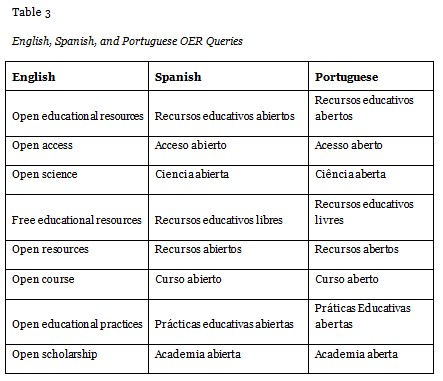
The table includes eight queries associated with OER in the three languages studied. These keywords were used as queries (using quotes in all cases) in this study. This multilingual sample of queries was retrieved from abstract and keywords results associated with OER searches made on Web of Knowledge and Scopus.
However in this study, the elements that allowed the comparison of digital resources (videos, documents, and academic publications) available on different platforms (Web of Knowledge, Scopus, YouTube, and Scribd) addressed the following common parameters: digital resources retrieved under the same set of queries (Table 3), published (online) during the same period of time (2007-2011), and offered in at least one of the three languages studied.
Two different types of platforms (academic and user-generated) were included because they made explicit references (in the title, description, abstract, keyword, or body of the text) to one or more of the eight queries associated with OER (Table 3).
The information was retrieved in September 2012 and the database for the search results can be accessed at the following URL:
https://docs.google.com/spreadsheet/ccc?key=0AmBXUpZP05UodHpqN1RqY2M4YjZnYlZ0VndHR09ud0E
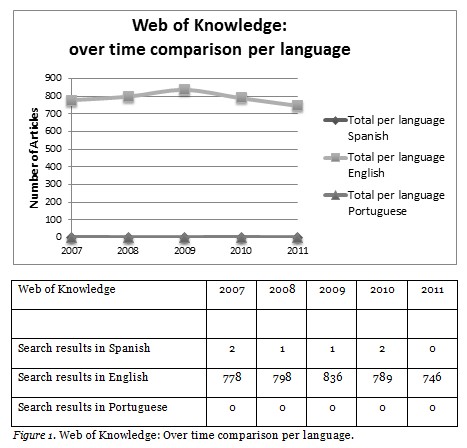
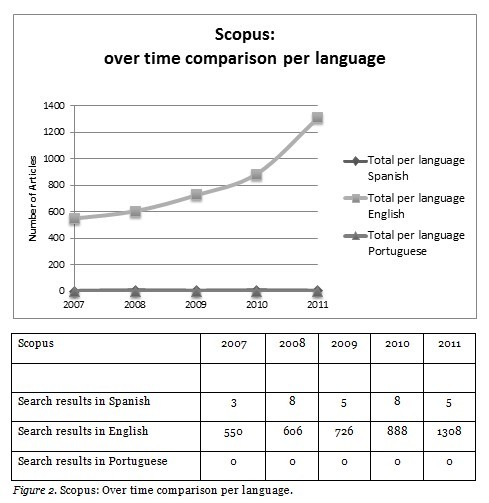
Figures 1 and 2 (academic journal databases) show remarkable difference between the English search results and the equivalent in Spanish and Portuguese. In the case of the Web of Knowledge, the difference between English and Spanish and Portuguese did not change much over time. This information is relevant because it illustrates a consistent interest in this field among the English speaking community. The language imbalance between English and non-English journals (previously described in the Methodology section) is reflected in Figures 1 and 2. The virtual lack of results in Spanish and Portuguese do not provide any conclusive information (apart from the still low presence of these languages).
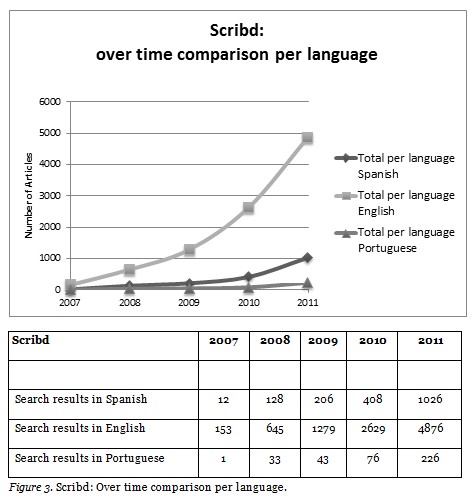
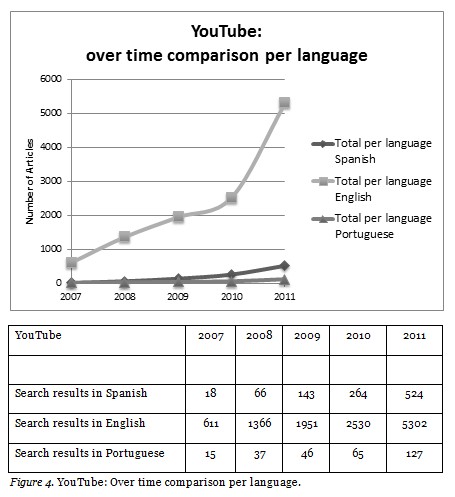
The data gathered from non-academic platforms (Scribd and YouTube) indicates that search results in English were continuously growing during the period studied. Concurrently, the search results indicate that Spanish, followed by Portuguese, grew, but at slower rates.
Nevertheless, in the period studied, the Spanish results grew more on Scribd and YouTube (85.5 and 29.1 respectively) than English (31.8 and 8.6). Similarly, in both platforms, the growth of Portuguese results was higher (226 and 8.4) or was very similar to the English growth (31.8 and 8.6) on Scribd and YouTube.
Contrary to what was observed in Figures 1 and 2, Figures 3 and 4 highlight that all languages (in different scales) registered an increasing interest in OER. Although these results are not conclusive, they suggest that non-academic platforms are becoming an increasingly relevant space of discussions about OER.
It is important to note that the general trend of search results show a growing language gap between the number of queries about OER retrieved in English and its equivalent in Spanish and Portuguese.
In most of the platforms included in this study, more content about OER was registered in 2011 than in 2007. Furthermore, in Scopus, Scribd, and YouTube, the amount of English content about OER was greater than in Spanish or Portuguese. Clear evidence of this growth can be found in the increase of English search results about OER retrieved from academic publications in Scopus, which increased over 2.3 times within the period 2007-2011.
Noteworthy differences were found in the non-academic platforms (Scribd and YouTube), where Spanish and Portuguese search results increased during the period studied (2007-2011). For both Scribd and YouTube, the language gap between English content about OER and the other two languages (Spanish and Portuguese) was smaller in 2011. For instance, for Scribd, the growth of the Spanish search results was 2.7 times higher than its English equivalent. In addition, during the same period, the Portuguese growth rate was 7.2 times higher than the English growth rate. On YouTube, the Spanish search results registered a growth rate that was 3.4 times higher than its English equivalent, while the growth rate of the Portuguese search results was only slightly lower (less than 1%) than the growth rate of the English search results.
For 2007, 166 search results were retrieved from Scribd for all three languages. In 2011, that number increased to 6,128. Similarly, the total volume of search results retrieved from YouTube for all three languages increased from 644 in 2007 to 5,953 in 2011. The total volume of search results in non-academic platforms (Scribd and YouTube) was considerably higher than the equivalent in the academic journal databases.
The results obtained in Scopus registered a constant growth of English search results during the period studied. By contrast, there was a limited or underrepresented number of academic publications available in Spanish or Portuguese on the Web of Knowledge and Scopus; thus, English was the only language that registered significant changes in the period studied.
The main aspect to be highlighted here is the results, which provide useful information to analyse OER from the language diversity perspective.
The growing rates of usage for the three languages studied represent an increasing interest in content about OER. The predominance of English in academic journal databases is unmistakable, while the volume of Spanish and Portuguese journals in these databases remains limited. By contrast, in non-academic platforms, Spanish and Portuguese content referring to OER is increasing at a rate that is faster than or similar to English. The results of this study show an increasing existence of resources about open education beyond academic journals. This trend was identified in all three languages studied.
The imbalance between languages can by no means be considered exclusive of OER; nevertheless, this situation is more evident in academic databases rather than in user-generated content platforms.
From the language perspective, the OER discussion has many challenges. A more evenly distributed language-based OER model seems to be a pending issue. A more language-diverse OER discussion will require a more comprehensive analysis of this topic in both the academic and non-academic domains. If these aspects are taken into account, it is likely that non-English speaking communities will receive a higher level of visibility.
The existing OER in English-speaking communities are not sufficient for global adoption and effective use of these resources. UNESCO (Daniel, et al., 2006; d Antoni, 2008) considers the lack of OER adoption in non-English speaking countries as an opportunity. However, the lack of trained users (learners and educators) from non-English speaking countries with the required skills to effectively create and repurpose OER and the absence of technology infrastructures result in a deeper divide between those who can exploit the benefits of OER and those who cannot. As described above, the adoption of OER must operate within contextual factors that vary by organisation, culture, legal, or academic factors. If these factors are not taken into account they can become barriers that challenge the expansion of OER (Hattaka, 2009; Stacey, 2007; Klemke et al., 2010, 75; Lecercle, 2011).
A growing interest in sharing open educational resources has been supported by a number of HE institutions, which, in turn, has promoted the principles of openness and free access as drivers of knowledge exchange. The OER initiatives described in this paper suggest the need for a new understanding of access to content capable of addressing the cultural and linguistic barriers that exist beyond opening the access to resources. This study discusses to what extent the interest in OER is adopted by different language-based communities, analysing different types of platforms over time. Consistent and increasing evidence was retrieved from non-academic databases (Scribd and YouTube), which indicated that, in most cases, English, Spanish, and Portuguese OER online content was increasing over time. This study can also be utilised to analyse the increasing relevance of technology to facilitate exchange and visibility of knowledge generated in academic and non-academic contexts.
The growing volume of digital content about OER in the user-generated content platforms challenges the retrieval and analysis of these resources in statistical studies. The increasing volume of content making reference to OER published in non-academic platforms (not necessarily peer-reviewed in many cases) suggests the importance of identifying and differentiating high-quality OER from the rest. Based on that, the content selection of high-quality resources could become a time consuming process. There are numerous opportunities for further research in this field. Supplementary research is required to analyse how the trends described in this study will evolve in the future. This study only included two non-English languages; future analysis of OER among Chinese, Arabic, or Russian speaking communities could significantly enhance the existing knowledge in this domain. Future studies must incorporate additional languages to determine if, and to what extent, the predominance of English in OER persists.
This study was supported through the Knetworks project (Knowledge Dissemination Network for the Atlantic Area) and in collaboration with the OportUnidad Project (ALFA III).
Atkins, D. E., Brown, J. S., & Hammond, A. L. (2007). A review of the open educational resources (OER) movement: Achievements, challenges, and new opportunities. San Francisco: The William and Flora Hewlett Foundation.
Banzato, M. (2012). Barriers to teacher educators seeking, creating and sharing open educational resources: An empirical study of the use of OER in education in Italy. 2012 15th International Conference on Interactive Collaborative Learning (ICL) (pp. 1–6). doi:10.1109/ICL.2012.6402105
Björk, B.-C., & Paetau, P. (2012). Open access to the scientific journal literature–status and challenges for the information systems community. Bulletin of the American Society for Information Science and Technology, 38(5), 39–44.
Budapest Open Access Initiative. (2002). Budapest Open Access Initiative. Retrieved from http://www.opensocietyfoundations.org/openaccess
Cape Town Open Education Declaration. (2007). Unlocking the promise of open educational resources. Retrieved from http://www.capetowndeclaration.org/read-the-declaration
Cartes-Velásquez, R., & Aravena Torres, P. (2012). Perfil bibliométrico de la odontología chilena, 2001-2010. Revista clínica de periodoncia, implantología y rehabilitación oral, 5(1), 5–8.
Daniel, J., Kanwar, A., & Uvalić-Trumbić, S. (2006). A tectonic shift in global higher education. Change: The Magazine of Higher Learning, 38(4), 16–23. doi:10.3200/CHNG.38.4.16-23.
D’Antoni, S. (2008). Recursos educativos abiertos y contenidos para la educación superior abiertos. Revista de Universidad y Sociedad del Conocimiento, RUSC, 4(1), 1-9.
Delasalle, J. (2012). Guest post: Hocus Scopus. The University of Warwick. Retrieved from http://blogs.warwick.ac.uk/libresearch/daily/200412.
Fishman, J. A. (1997). In praise of the beloved language: A comparative view of positive ethnolinguistic consciousness. Berlin: Walter de Gruyter.
García-Cepero, M. C. (2008). Panorama de las publicaciones seriadas y producción académica en el área de Educación, Iberoamérica. Revista Internacional de Investigación en Educación, 1(1), 13–30.
González-Alcaide, G., Castelló-Cogollos, L., Castellano-Gómez, M., Agullo-Calatayud, V., Aleixandre-Benavent, R., Álvarez, F., &Valderrama-Zurián, J. (2012). Scientific publications and research groups on alcohol consumption and related problems worldwide: Authorship analysis of papers indexed in PubMed and Scopus Databases (2005 to 2009). Alcoholism: Clinical and Experimental Research, n/a–n/a. doi:10.1111/j.1530-0277.2012.01934.x.
Hatakka, M. (2009). Build it and they will come? – Inhibiting factors for reuse of open content in developing countries. The Electronic Journal of Information Systems in Developing Countries, 37(0) (April 19). Retrieved from http://www.ejisdc.org/ojs2.../index.php/ejisdc/article/view/545.
Häyrinen-Alestalo, M., & Peltola. U. (2006). The problem of a market-oriented university. Higher Education, 52(2), 251–281.
Hodgkinson-Williams, C., Willmers, M., & Gray, E. (2009). International environmental scan of the use of ICTs for teaching and learning in higher education. Centre of Educational Technology, University of Cape Town. Retrieved from http://www.cet.uct.ac.za/files/file/OS%20PositionPaper3%20_%20%20Final%20typeset.pdf
Huang, W.-H. D., Lin, M.-F. G., & Shen, W. (2012). Understanding Chinese-speaking open courseware users: a case study on user engagement in an open courseware portal in Taiwan. Open Learning: The Journal of Open, Distance and e-Learning, 27(2), 169–182. doi:10.1080/02680513.2012.678614
Hurmelinna, P., Kyläheiko, K., & Jauhiainen.T. (2007). The Janus face of the appropriability regime in the protection of innovations: Theoretical re-appraisal and empirical analysis. Technovation, 27(3) (March), 133–144. doi:10.1016/j.technovation.2005.09.011.
Inamorato, A., Cobo, C., & Costa, C. (2012). Compendium open educational resources: Cases from Latin America and Europe in higher education. Niterói: CEAD-UFF. Retrieved from http://ssrn.com/abstract=2193109
Internet World Stats. (2011). Internet users by language. Retrieved from http://www.internetworldstats.com/stats7.htm.
JISC Digital Media. (2013). YouTube and Vimeo for education. Retrieved from http://www.jiscdigitalmedia.ac.uk/guide/youtube-vimeo-education
Kanwar, A., Kodhandaraman. B, & Umar, A. (2010). Toward sustainable open education resources: A perspective from the global South. American Journal of Distance Education, 24(2), 65–80. doi:10.1080/08923641003696588.
Klemke, R., Kalz, M., Specht, M., & Ternier , S. (2010). Open educational resources: Conversations in cyberspace. British Journal of Educational Technology, 41(6), 968–970.
Knyazeva, S. (2010). Open educational resources in CIS: Preliminary study of the state-of-the-art and prospects for development. BSU. Retrieved from http://elib.bsu.by/handle/123456789/13100
Larivière, V., Archambault, E. Gingras,Y., & Vignola-Gagné, E. (2006). The place of serials in referencing practices: Comparing natural sciences and engineering with social sciences and humanities. Journal of the American Society for Information Science and Technology, 57(8), 997–1004. doi:10.1002/asi.20349.
Lecercle, D. (Ed.). (2011). Giving knowledge for free: The emergence of open educational resources. Organisation for Economic Co-operation and Development. Retrieved from http://www.oecd.org/dataoecd/35/7/38654317.pdf
Lewis, M. P. (2009). Ethnologue: Languages of the world. Dallas: SIL International. Retrieved from http://www.ethnologue.com.
Masterman, L., & Wild, J. (2011). JISC Open Educational Resources Programme: Phase 2 OER impact study (Research Report). Oxford: University of Oxford.
Meho, L. I., & Yang, K. (2006). A new era in citation and bibliometric analyses: Web of Science, Scopus, and Google Scholar. arXiv:cs/0612132. Retrieved from http://arxiv.org/abs/cs/0612132.
Meneghini, R., & Packer, A. (2007). Is there science beyond English? Initiatives to increase the quality and visibility of non-English publications might help to break down language barriers in scientific communication. EMBO Reports, 8(2), 112–116. doi:10.1038/sj.embor.7400906.
Ouane, A. (2003). Towards a multilingual culture of education. Paris: UNESCO Institute of Education. Retrieved from http://www.unesco.org/education/uie/pdf/uiestud41.pdf.
Pleabani, M. (2010). Web of Science. Thomson Reuters. Retrieved from www.cab.unipd.it/system/files/Web_of_Science.pdf.
Quacquarelli Symonds. (2012). Paper and citations methodology. Quacquarelli Symonds Limited. Retrieved from http://www.iu.qs.com/university-rankings/rankings-indicators/methodology-papers-per-facultycitations-per-paper/.
Richter, Th., & McPherson, M. (2012). Open educational resources: Education for the world? Learning Context Metadata, 33(2), 201–219. doi:10.1080/01587919.2012.692068.
Rossini, C. (2010). Green-Paper: The state and challenges of OER in Brazil: From readers to writers? (SSRN Scholarly Paper No. ID 1549922). Rochester, NY: Social Science Research Network. Retrieved from http://papers.ssrn.com/abstract=1549922
SciVerse Scopus. (2011). Content coverage guide. Elsevier. Retrieved from http://www.info.sciverse.com/UserFiles/sciverse_scopus_content_coverage_0.pdf.
Scribd. (2012). Scribd: The world’s largest online library. Read, publish, and share documents and written works. Retrieved from http://www.scribd.com.
Stacey, P. (2007). Open educational resources in a global context. First Monday, 12(4).
Stankus, T. (1987). Scientific journals: Issues in library selection and management. New York: Haworth Press .
The Higher Education Academy, and JISC. (2011). Open educational resources infokit: Stakeholders and benefits. JISC/HE Academy UKOERProgramme. Retrieved from https://openeducationalresources.pbworks.com/w/page/24838012/Stakeholders%20and%20benefits.
Thompson Reuters. (2012). Journal citation report. Retrieved from http://thomsonreuters.com/products_services/science/science_products/a-z/journal_citation_reports.
UNESCO. (2012). Paris Declaration on Open Educational Resources. Retrieved from http://www.unesco.org/new/fileadmin/MULTIMEDIA/HQ/CI/CI/pdf/Events/Paris%20OER%20Declaration_01.pdf
UNESCO, & COL. (2011). Guidelines for open educational resources (OER) in higher education. Columbia - Paris: UNESCO. Retrieved from http://www.col.org/PublicationDocuments/Guidelines_OER_HE.pdf.
UNESCO, AUF, & OIF. (2009). Déclaration de Dakar sur les Ressources Éducatives Libres. UNESCO, the Agence universitaire de la Francophonie (AUF) and the International Organization of la Francophonie (OIF). Retrieved from http://oercongress.weebly.com/uploads/4/1/3/4/4134458/05-rel-declaration_de_dakar-5_mars_2009.pdf
US Census Bureau, Public Information. (2012). Facts for features: Hispanic Heritage Month 2012: Sept. 15-Oct. 15 - Facts for features & special editions - newsroom. Retrieved from http://www.census.gov/newsroom/releases/archives/facts_for_features_special_editions/cb12-ff19.html.
Velterop, J. (2007). Open access is a choice. Zeitschrift Fur Bibliothekswesen Und Bibliographie, 54(4/5), 268.
Wiley, D. (2010). Impediments to Learning Object Reuse and Openness as a Potential Solution. Revista Brasileira De Informática Na Educação, 17(03). doi:10.5753/RBIE.2009.17.03.08.
Wiley, D., & Gurrell, S. (2009). A decade of development…. Open Learning: The Journal of Open, Distance and e-Learning, 24(1), 11–21. doi:10.1080/02680510802627746.
Willems, J., & Bossu.C. (2012). Equity considerations for open educational resources in the glocalization of education. Distance Education, 33(2), 185–199. doi:10.1080/01587919.2012.692051.
Willinsky, J. (2010). The stratified economics of open access. OJS på dansk, 1(1). Retrieved from http://ojs.statsbiblioteket.dk/index.php/ojssb/article/view/2706
Yale News. (2011). Yale adds 10 new Open Yale courses. Retrieved from http://news.yale.edu/2011/04/15/yale-adds-10-new-open-yale-courses.
YouTube. (2012). Frequently asked questions. Retrieved from http://www.youtube.com/t/faq.